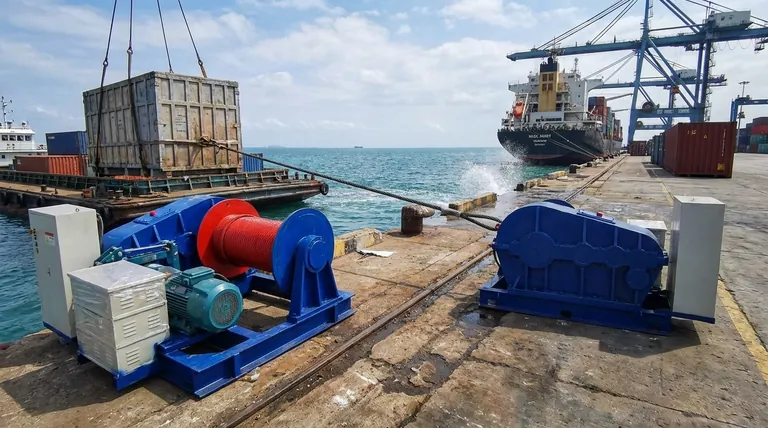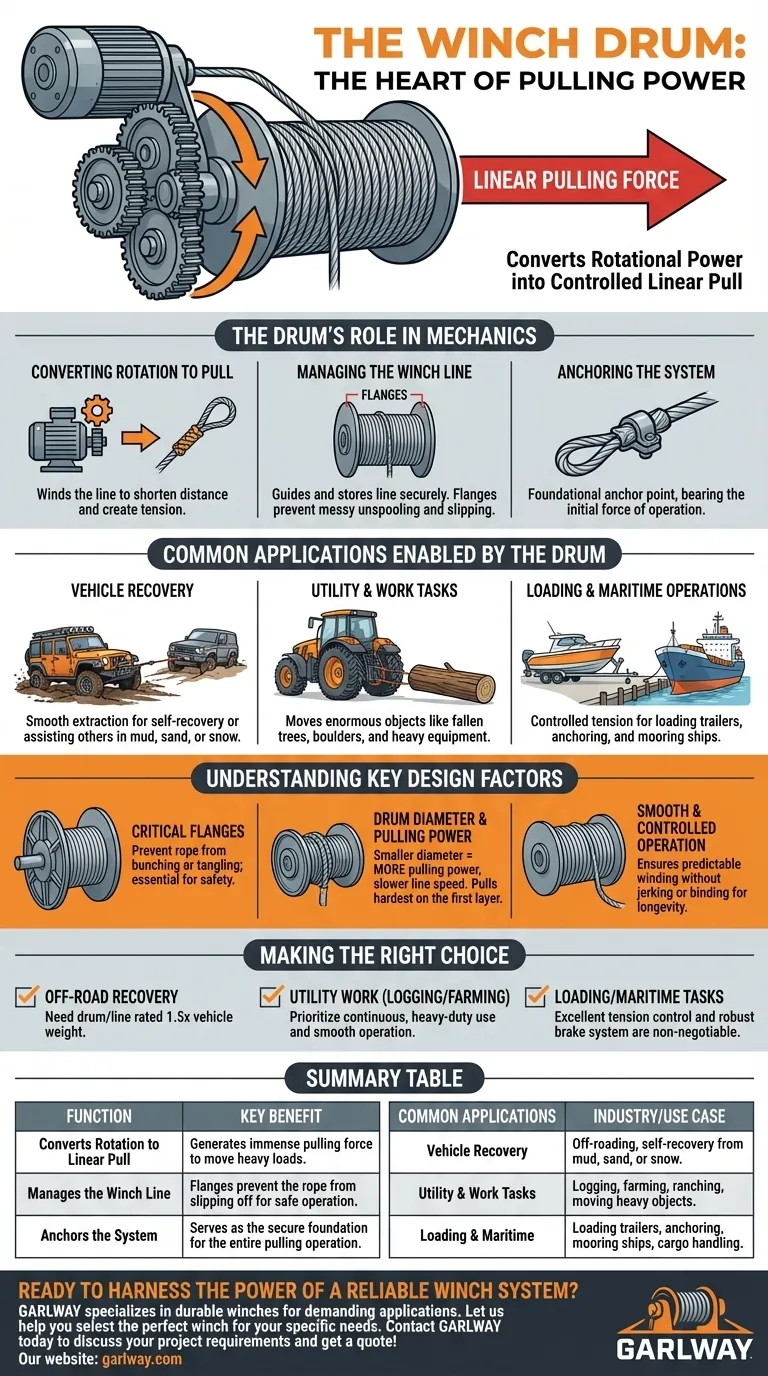At its core, a winch drum is the central component that spools a rope or cable, converting the winch motor's rotational power into linear pulling force. It is the cylindrical spool that winds the line in or lets it out, equipped with flanges on its sides to prevent the rope from slipping off. This simple mechanical action is what allows a winch to move incredibly heavy loads.
The winch drum is not merely a storage spool for the cable; it is the very heart of the winch system. Its job is to manage the line and translate the machine's power into the controlled, linear pull required to recover vehicles, move heavy objects, and perform critical work tasks.

The Drum's Role in Winch Mechanics
A winch creates immense pulling force through a simple principle. The drum is the component that puts this principle into action.
Converting Rotation to Linear Pull
The winch motor and gears turn the drum. As the drum rotates, it neatly winds the winch line (wire rope or synthetic rope) around itself. This winding action shortens the line between the winch and the anchor point, creating the powerful tension needed to move a load.
Managing the Winch Line
The drum is engineered to guide and store the line securely. The flanges—the raised edges on either side of the drum—are a critical safety feature. They prevent the line from unspooling messily or slipping off the drum under load, which would cause a catastrophic failure.
Anchoring the System
One end of the winch line is securely fastened to the drum itself. This makes the drum the foundational anchor point of the entire pulling system, bearing the initial force of any operation.
Common Applications Enabled by the Drum
The winch drum's ability to generate controlled pulling force makes it indispensable across various industries and activities.
Vehicle Recovery
This is the most well-known application. A winch can pull a vehicle that is stuck in mud, sand, snow, or any other obstacle. The drum evenly spools the rope, allowing for the smooth extraction of your own vehicle (self-recovery) or another person's.
Utility and Work Tasks
Winches are essential tools in industries like logging, farming, and ranching. The force generated by the winding drum can be used to move enormous objects like fallen trees, boulders, or other heavy equipment that would otherwise be immovable.
Loading and Maritime Operations
The controlled tension provided by a winch drum is perfect for loading vehicles or heavy equipment onto trailers. In the maritime industry, drum winches are used for critical tasks like anchoring, mooring ships to a dock, towing, and handling heavy cargo.
Understanding Key Design Factors
Not all winch drums are identical. Their design directly impacts the winch's performance and safety.
The Critical Role of Flanges
As mentioned, the flanges prevent the rope from slipping off the sides. Without robust, correctly sized flanges, the rope could "bunch up" or become tangled, compromising the pull and potentially damaging the line.
Drum Diameter and Pulling Power
The diameter of the drum affects the winch's speed and power. A smaller diameter provides more pulling power but a slower line speed. The amount of rope spooled on the drum also impacts pulling force; a winch pulls hardest on the first layer of rope closest to the drum's surface.
Smooth and Controlled Operation
The entire system is designed for the smooth, predictable winding and unwinding of the line. A properly functioning drum ensures there is no jerking or binding, which is crucial for both safety and the longevity of the equipment.
Making the Right Choice for Your Goal
Understanding the drum's function helps you select the right winch for your needs.
- If your primary focus is off-road vehicle recovery: You need a winch system with a drum and line rated to pull at least 1.5 times your vehicle's gross weight.
- If your primary focus is utility work like logging or farming: Prioritize a winch built for continuous, heavy-duty use with a drum designed for smooth and controlled operation under constant tension.
- If your primary focus is loading or maritime tasks: A winch with excellent tension control and a robust drum and brake system is non-negotiable for safe mooring and cargo handling.
Ultimately, the winch drum is the simple, powerful heart of a winch, translating rotational energy into the practical force needed to overcome immense challenges.
Summary Table:
| Function | Key Benefit |
|---|---|
| Converts Rotation to Linear Pull | Generates immense pulling force to move heavy loads. |
| Manages the Winch Line | Flanges prevent the rope from slipping off for safe operation. |
| Anchors the System | Serves as the secure foundation for the entire pulling operation. |
| Common Applications | Industry/Use Case |
| Vehicle Recovery | Off-roading, self-recovery from mud, sand, or snow. |
| Utility & Work Tasks | Logging, farming, ranching, moving heavy objects. |
| Loading & Maritime | Loading trailers, anchoring, mooring ships, cargo handling. |
Ready to harness the power of a reliable winch system?
For construction companies and contractors worldwide, a high-performance winch is essential for safe and efficient heavy lifting, recovery, and material handling. GARLWAY specializes in durable construction machinery, including robust winches designed for demanding applications.
Let us help you select the perfect winch for your specific needs. Our experts can guide you to a solution that ensures maximum pulling power and operational safety.
Contact GARLWAY today to discuss your project requirements and get a quote!
Visual Guide

Related Products
- Best 18000 Pound Drum Anchor Trailer Winch
- Electric 120V Boat Winch by Badlands
- 12000 lb Heavy Duty Electric Boat Winch
- Ready Mixer Machine for Construction Ready Mix Machinery
- Electric Hoist Winch Boat Anchor Windlass for Marine Applications
People Also Ask
- What is the purpose of a trailer winch? Achieve Safe & Effortless Heavy Loading
- What is a trailer winch used for? Achieve Safe, Effortless Heavy Load Transport
- What is the primary function of trailer winches? Effortlessly Load Heavy Boats & Equipment
- How are trailer winch sizes determined? Match Capacity to Your Boat's Weight for Safe Loading
- How do trailer winches benefit boat owners? Achieve Safe & Effortless Boat Loading



















